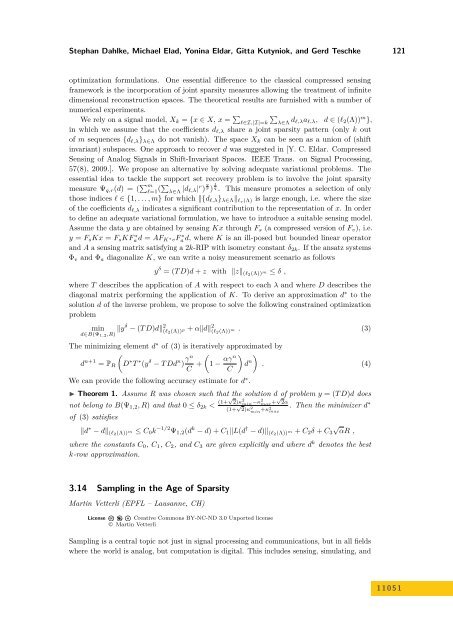Volume 1, Issue 1, January 2011 - DROPS - Schloss Dagstuhl
Volume 1, Issue 1, January 2011 - DROPS - Schloss Dagstuhl
Volume 1, Issue 1, January 2011 - DROPS - Schloss Dagstuhl
You also want an ePaper? Increase the reach of your titles
YUMPU automatically turns print PDFs into web optimized ePapers that Google loves.
Stephan Dahlke, Michael Elad, Yonina Eldar, Gitta Kutyniok, and Gerd Teschke 121<br />
optimization formulations. One essential difference to the classical compressed sensing<br />
framework is the incorporation of joint sparsity measures allowing the treatment of infinite<br />
dimensional reconstruction spaces. The theoretical results are furnished with a number of<br />
numerical experiments.<br />
We rely on a signal model, Xk = {x ∈ X, x = �<br />
ℓ∈I,|I|=k<br />
�<br />
λ∈Λ dℓ,λaℓ,λ, d ∈ (ℓ2(Λ)) m },<br />
in which we assume that the coefficients dℓ,λ share a joint sparsity pattern (only k out<br />
of m sequences {dℓ,λ}λ∈Λ do not vanish). The space Xk can be seen as a union of (shift<br />
invariant) subspaces. One approach to recover d was suggested in [Y. C. Eldar. Compressed<br />
Sensing of Analog Signals in Shift-Invariant Spaces. IEEE Trans. on Signal Processing,<br />
57(8), 2009.]. We propose an alternative by solving adequate variational problems. The<br />
essential idea to tackle the support set recovery problem is to involve the joint sparsity<br />
measure Ψq,r(d) = ( �m ℓ=1 (�λ∈Λ<br />
|dℓ,λ| r ) q<br />
r ) 1<br />
q . This measure promotes a selection of only<br />
those indices ℓ ∈ {1, . . . , m} for which �{dℓ,λ}λ∈Λ�ℓr(Λ) is large enough, i.e. where the size<br />
of the coefficients dℓ,λ indicates a significant contribution to the representation of x. In order<br />
to define an adequate variational formulation, we have to introduce a suitable sensing model.<br />
Assume the data y are obtained by sensing Kx through Fs (a compressed version of Fv), i.e.<br />
y = FsKx = FsKF ∗ a d = AFK∗vF ∗ a d, where K is an ill-posed but bounded linear operator<br />
and A a sensing matrix satisfying a 2k-RIP with isometry constant δ2k. If the ansatz systems<br />
Φv and Φa diagonalize K, we can write a noisy measurement scenario as follows<br />
y δ = (T D)d + z with �z� (ℓ2(Λ)) m ≤ δ ,<br />
where T describes the application of A with respect to each λ and where D describes the<br />
diagonal matrix performing the application of K. To derive an approximation d ∗ to the<br />
solution d of the inverse problem, we propose to solve the following constrained optimization<br />
problem<br />
min<br />
d∈B(Ψ1,2,R) �yδ − (T D)d� 2 (ℓ2(Λ)) p + α�d�2 (ℓ2(Λ)) m . (3)<br />
The minimizing element d∗ of (3) is iteratively approximated by<br />
d n+1 �<br />
= PR D ∗ T ∗ (y δ − T Dd n ) γn<br />
C +<br />
�<br />
1 − αγn<br />
�<br />
d<br />
C<br />
n<br />
�<br />
. (4)<br />
We can provide the following accuracy estimate for d ∗ .<br />
◮ Theorem 1. Assume R was chosen such that the solution d of problem y = (T D)d does<br />
not belong to B(Ψ1,2, R) and that 0 ≤ δ2k < (1+√2)κ 2<br />
min−κ2max +√2α (1+ √ 2)κ2 min +κ2max of (3) satisfies<br />
. Then the minimizer d ∗<br />
�d ∗ − d� (ℓ2(Λ)) m ≤ C0k −1/2 Ψ1,2(d k − d) + C1�L(d † − d)� (ℓ2(Λ)) m + C2δ + C3<br />
√ αR ,<br />
where the constants C0, C1, C2, and C3 are given explicitly and where d k denotes the best<br />
k-row approximation.<br />
3.14 Sampling in the Age of Sparsity<br />
Martin Vetterli (EPFL – Lausanne, CH)<br />
License Creative Commons BY-NC-ND 3.0 Unported license<br />
© Martin Vetterli<br />
Sampling is a central topic not just in signal processing and communications, but in all fields<br />
where the world is analog, but computation is digital. This includes sensing, simulating, and<br />
1 1 0 5 1













